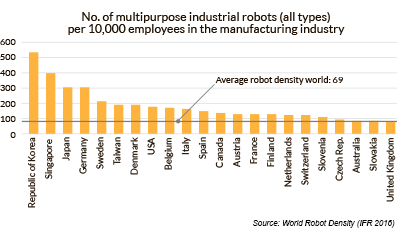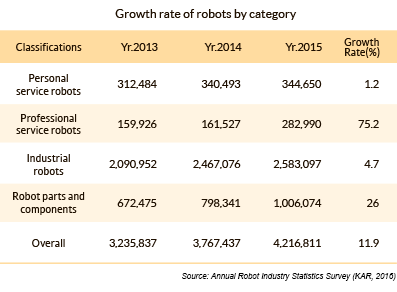
South Korea is known as the world leader in robot utilization for
the manufacturing industry. The country also has the second
largest market for industrial robots and is a key player in the service robot sector. With the Fourth Industrial Revolution fast
approaching, robot technology along with technology related to
artificial intelligence (AI), Internet of Things (IoT), augmented
reality (AR) and virtual reality (VR) are receiving the spotlight.
As such, the Korean government aims to lead this revolution with
the help of the booming robot industry. In this article, the status
of Korean robot industry along with the Korean government’s
robot policies will be discussed. After that, the prospects of
Korean robot industry will be assessed with consideration of new
trends in robotics.
According to the IFR World Robotics Report 2016, the global
robot market grew 9.7 percent to USD 17.9 billion, an increase of
13 percent over the last six years. Industrial robots1 still dominated the market whereas personal service robots showed a steep
growth rate and are expected to lead the development of the robot
industry. The personal service robot market stood at USD 2.22
billion, an increase of 3.8 percent, while the professional service
robot market hit USD 4.6 billion, growing by 13.8 percent.
At the 2017 RobotWorld2 , a remarkable trend of future industrial robots was featured at the collaborative robot pavilion. It is
predicted that collaborative robots will lead the future industrial
robot market by being easy-to-use, cost effective and safe. IFR
also points out that the rise of the one person family and the dual
income family, along with an ageing society, will give birth to the
rise of the personal service robot market in the coming years.
Professional service robots such as medical robots, logistics
mobile robots and military robots are driving the market. IFR predicts the market of medical robots and logistics robots will
increase sharply in five years.
To more closely examine the Korean robot industry,
two different sets of data were referred to in this article—the IFR World
Robot Statistics Report 2016 and the Annual Robot Statistics
Survey 2016 of KAR.
According to the IFR report, Korea was the world’s
second-largest market for industrial robots. In 2015, 38,285 new robots
were installed in Korea, 55 percent higher than in 2014. The
growth rate from 2010 and 2015 amounted to +10 percent. As for
production, 31,940 units were produced, and this was 19 percent
higher than the amount in 2014. In total, this amounted to about
12 percent of the global robot production. Furthermore, Korea
was leading in the robot density category (the number of industrial robots per 10,000 workers in the manufacturing industry).

According to the Annual Robot Statistics Survey by KAR,
there are about 2,000 companies specializing in industrial
robots, service robots, and robot parts and components in Korea.
90 percent of the companies are small and medium-enterprises
(SMEs) and their production volume stand at less than USD 1
million. Meanwhile, the Korean robot market in 2015 amounted
to KRW 4.17 trillion (USD 368 million), an 11.9 percent
increase compared to 2014.
By category, the Korean personal service robot market rose
1.2 percent of KRW 345 billion (USD 304 million) from 340
billion. Educational robots and personal household robots led
the market. As for the professional service robot market, its total
sales volume was KRW 283 billion (USD 250 million), a 75.2
rise compared to 2014. In this category, medical and societal
safety robots were the major products that were sold.
Meanwhile, the industrial robot market grew KRW 2.58 trillion (USD 227 million) recording a 4.7 percent rise from 2014.

The market share of manufacturing robots amounted to 61
percent, with service robots standing at 15 percent and robot
parts making up 24 percent of market share. In regards to
growth rates, manufacturing robots grew 3.3 percent while service robots grew by 23 percent. More notably, professional service robots such as medical robots and robots for military use
grew by an astonishing 78 percent. What is also notable is that
robot parts such as reducers, motion controllers, sensors and
cables grew by 43.6 percent. In 2015, the Korean robot market
(production basis) increased by 17 percent to KRW 4 trillion
(USD 3.52 billion) from the previous year (KRW 3.4 trillion in
2014). As for industrial robots, production increased 4.7 percent
from the previous year to KRW 2.58 trillion.
A recent report by the Ministry of Science and ICT shows that
Korea lags slightly behind in robot technology compared to
developed countries like the United States and Japan. According
to the report, Korea is 4.2 years behind the United States and 1.2
years behind Japan. The country is, however, three years ahead
of China.
In a bid to support the growth of robotics companies here in
Korea, the Ministry of Trade, Industry and Energy (MOTIE)
announced its ‘5-Year Plan of Robot Industry Development’ in
November 2016, which seeks to invest KRW 500 billion (USD
440 million) to 2022. The main policy directions are to expand
public demand and strengthen the suppliers’ capacity. The ministry plans to increase demand through the use of more service
robots in the public sector and the development of smart factories.
The ministry plans to build state-of-the–art manufacturing robots in connection with smart factories. To expand the service robot market, it aims to start 80 pilot projects in the fields of medicine, rehabilitation and social safety.
As for strengthening the capacity of robot suppliers, the government will build 10 to 15 advanced robot commercialization research centers nationwide, as well as AI/ICT convergence centers and humanoid robot research centers.
MOTIE aims to build up high-quality components of reducers, sensors, controllers and motors by reducing reliance on global robot parts suppliers. The budget for this project amounts
to KRW 350 billion (USD 310 million).
The ministry will also strengthen overseas marketing bases, which will promote welding robots, rehabilitation robots, robots for road cleaning and so on. For overseas
market expansion, it is
considering dispatching trade missions at targeted overseas
areas. In addition, the government will promote joint R&D projects with leading countries in robot technology. On this note, in
2016, Korea and the United States signed an MOU to cooperate
in the fields of disaster response robotics by organizing robot
workshops and R&D projects.
During the last decade, Korea has been more focused on service robotics. Although Korea has acquired strong core technology, service robots have so far not been able to gather a sizable
market. As a result, the Korean government and the private sector are now focusing on potentially promising fields such as collaborative robots and surgical robots. Recently, two major
Korean companies, Hanwha Techwin and Doosan Robotics,
shook the robot industry by unveiling their state-of-the-art collaborative robots at the RobotWorld exhibition. Collaborative
robots were selected as one of the five promising robot fields3
based on growth potential and domestic demand by the Korean
government. As Market & Market (2016) predicts, the global
collaborative robot market is expected to reach KRW 3.6 trillion
(USD 3.1 billion) by 2022.
Due to population ageing, the medical robot market is expected to be increasingly promising in the years ahead. As for surgical robots, companies like Koh Young Technology and Meere
Company are expected to take the lead in the global surgical
robot market. Meanwhile, traditional industrial robot companies
like Hyundai Robotics, Robostar and TES will most likely continue to do well since OLED and semiconductor business have a
future positive outlook.
In the personal service robot market, Samsung, LG and Yujin
Robot are on the right track, thanks to the growing vacuum
cleaning market, while ROBOTIS and RoboRobo are showing
steadfast growth in the educational robot market.
Korea is one of the world’s top five leaders in the robot industry and is largely recognized for its technological prowess. Case in point, the country’s very own walking humanoid robot called HUBO won the DARPA Robotics Challenge in 2015, further shedding international spotlight on Korea’s robot industry. Although the country does not have industrial robot giants like ABB, Fanuc, Yaskawa or KUKA, Korea’s innovative technology and entrepreneurial spirit will continue to shape the international market.
* The opinions expressed in
this article are the author's own and
do not reflect the view of KOTRA.